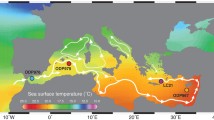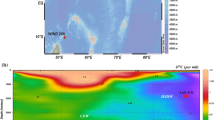Abstract
Paleotemperature estimates calculated by the SIMMAX Modern Analog Technique are presented for two gravity cores from the Rio Grande Rise, one from the Brazil Slope, and one from the Ceara Rise. The estimates are based on comparisons between modern and fossil planktonic foraminiferal assemblages and were carried out on samples from Quaternary sediments. Estimated warm-season temperatures from the Rio Grande Rise (at approx. 30° S) range from around 19°C to 24°C, with some coincidence of warm peaks with interglacial stages. The temperature estimates (also warm-season) from the more tropical Brazil Slope (at approx. 8° S) and Ceara Rise (at approx. 4° N) cores are more stable, remaining between 26°C and 28°C throughout most of their lengths. This fairly stable situation in the tropical western Atlantic is interrupted in oxygen isotope stage 6 by a significant drop of 2–3°C in both of these cores. Temperature estimates from the uppermost samples in all cores compare very well to the modern-day measured values. Affinities of some foraminiferal species for warmer or cooler surface temperatures are identified within the temperature range of the examined samples based on their abundance values. Especially notable among the warmer species are, Globorotalia menardii, Globigerinita glutinata,Globigerinoides ruber, and Globigerinoides sacculifer. Species indicative of cooler surface temperatures include Globorotalia inflata, Globigerina bulloides, Neogloboquadrina pachyderma, and Globigerina falconensis. A cluster analysis was carried out to assist in understanding the degree of variation which occurs in the foraminiferal assemblages, and how temperature differences influence the faunal compositions of the samples. It is demonstrated that fairly similar samples may have unexpectedly different estimated temperatures due to small differences in key species and, conversely, quite different assemblages can result in similar or identical temperature estimates which confirms that other parameters than just temperature affect faunal content.
Access this chapter
Tax calculation will be finalised at checkout
Purchases are for personal use only
Preview
Unable to display preview. Download preview PDF.
Similar content being viewed by others
References
Bé AWH (1967) Fiches d’Identification du zooplancton. Conseil Permanent International pour l’Exploration de la Mer. Zooplankton sheet 108. Charlottenlund Slot, Danemark
Bé AWH, Tolderlund DS (1971) Distribution and ecology of living planktonic foraminifera in surface wa ters of the Atlantic and Indian Oceans. In: Funnell BM, Riedel RR (eds) The Micropaleontology of the Oceans. Cambridge Univ Press, New York, pp 105–149
Bleil UV, Spieß V, Wefer G (1994) Geo Bremen SOUTH ATLANTIC (1993), Cruise No. 23,4 Feb.-12 April 1993. METEOR Ber Univ Hamburg 94-1, pp 1–261
Brassell SC, Eglinton G, Marlowe IT, Pflaumann U, Sarnthein M (1986) Molecular stratigraphy: A new tool for climatic assessment. Nature 320:129–133
Broecker W (1995) Cooling the tropics. Nature 376: 212–213
Broecker W (1996) Glacial climate in the tropics. Science 272:1902–1904
CLIMAP Project Members (1981) Seasonal reconstructions of the Earth’s surface at the last glacial maxi mum. Geol Soc Amer Map and Chart Series MC-36
Davis JC (1986) Cluster analysis. In: Statistics and Data Analysis in Geology. J Wiley & Sons, New York, pp 502–515
Emiliani C (1955) Pleistocene temperatures. J Geol 63: 538–578
Epstein S, Buchsbaum R, Lowenstam HA, Urey HC (1953) Revised carbonate water isotopic temperature scale. GSA Bulletin 64:1315–1326
Fairbanks RG, Sverdlove M, Free R, Wiebe PH, Bé AWH (1982) Vertical distribution and isotopic fractionation of living planktonic foraminifera from the Panama Basin. Nature 298:841–844
Fishbein E, Patterson RT (1993) Error-weighted maximum likelihood (EWML): a new statistically based method to cluster quantitative micropaleontological data. J Paleontol 67(3): 475–486
Guilderson TP, Fairbanks RG, Rubenstone JL (1994) Tropical temperature variations since 20,000 years ago: modulating interhemispheric climate change. Science 263: 663–665
Hair JF Jr, Anderson RE, Tatham RL, Black WC (1984) Chapter 8: Cluster Analysis. In: Multivariate Data Analysis With Readings, 4th ed. Prentice Hall Inter national Inc, Englewood Cliffs, NJ, pp 420–483
Hutson WH (1977) Transfer functions under no-analog conditions: Experiments with Indian Ocean plank-tonic foraminifera. QuatRes 8:355–367
Hemleben C, Spindler M, Anderson OR (1989) Tax onomy and species features. In: Hemleber C, Spindler M, Anderson OR (eds) Modern Planktonic Foraminifera. Springer, Berlin Heidelberg New York, pp 8–32
Imbrie J, Kipp NJ (1971) A new micropaleontological method for quantitative paleoclimatology: Application to a late Pleistocene Caribbean core. In: Turekian KK (ed) The late Cenozoic glacial ages. Yale Univ Press, New Haven, Conn, pp 71–181
Kipp NG (1976) New transfer function for estimating past sea surface conditions from sea bed distribution of planktonic foraminiferal assemblages in the North Atlantic. In: Cline RM, Hays JD (eds) Investigation of Southern Ocean paleoceanography and Paleoclimatology. Mem Geol Soc Am 145, pp 3–42
Levitus S (1982) Climatological atlas of the world ocean. NOAA Prof. Paper 13, US Govt Printing Office, Washington DC, pp 1–173
Mclntyre A, Ruddiman WF, Karlin K, Mix AC (1989) Surface water response of the equatorial Atlantic Ocean to orbital forcing. Paleoceanography 4(1): 19–55
Mix AC (1987) The oxygen-isotope record of glaciation. In: Ruddiman WF, Wright HE Jr (eds) North America and adjacent oceans during the last deglaciation. Geol Soc Amer, The Geology of North America, Boul der, Colorado, V K-3, pp 111–135
Mix AC, Morey AE (1996) Climate feedback and Pleistocene variations in the Atlantic South Equa torial Current. In: Wefer G, Berger WH, Siedler G, Webb DJ (eds) The South Atlantic: Present and Past Circulation. Springer, Berlin Heidelberg New York, pp 503–525
Molfino B, Kipp NG, Morley JJ (1982) Comparison of foraminiferal, coccolithophorid and radiolarian paleotemperature equations: Assemblage coher ency and estimate concordancy. Quat Res 17: 279–313
Morgan WJ (1972) Deep mantle convection: plumes and plate motions. Amer Assoc Petrol Geol Bull 56: 203–213
Natland ML (1933) The temperature-and-depth distribution of some Recent and fossil Foraminifera in the southern California region. Scripps Inst Ocean Bull CechSer 3:225–230
Oberhänsli H, Bénier C, Meinecke G, Schmidt H, Schneider R, Wefer G (1992) Planktonic foraminifers as tracers of ocean currents in the eastern South Atlantic. Paleoceanography 7 (5): 607–632
Parker FL (1962) Planktonic foraminiferal species in Pacific sediments. Micropaleontology 8:219–254
Patzold J, Bickert T, Bruck L, Gaedicke C, Heidland K, Meinecke G, Mulitza S (1993) Bericht und erste Ergebnisse uber die Meteor-Fahrt M 15/2, Rio de Janeiro-Vitoria, 18.1.-7.2.1991. BerFachberGeowiss Univ Bremen 17, pp 1–46
Patzold J, Heidland K, Zenk W, Siedler G (1996) On the Bathymetry of the Hunter Channel. In: Wefer G, Berger WH, Siedler G, Webb DJ (eds) The South Atlantic: Present and Past Circulation. Springer, Berlin Heidelberg New York, pp 355–361
Peterson RG, Stramma L (1991) Upper-level circulation in the South Atlantic Ocean. Progr Oceanogr 26: 1–73
Pflaumann U, Duprat J, Pujol C, Labeyrie LD (1996) SIMMAX: A modern analog technique to deduce Atlantic sea surface temperatures from plank tonic foraminifera in deep-sea sediments. Paleoceanography 11 (1): 15–35
Prahl FG, Pisias N, Sparrow MA, Sabin A (1995) Assess ment of sea-surface temperature at 42°N in the Cali fornia Current over the last 30,000 years. Paleoceanography 10 (4): 763–773
Prell WL (1985) The stability of low latitude sea surface temperatures: An evaluation of the CLIMAP recon struction with emphasis on the positive SST anoma lies. Rep. TR 025, US Dept of Energy, Washington DC, pp 1–60
Raup DM, Stanley SM (1978) Paleoecology. In: Principles of Paleontology. Second Edition, Freeman WH & Co, San Francisco, pp 231–302
Ravelo AC, Fairbanks RG, Philander SGH (1990) Recon structing tropical Atlantic hydrography using plank tonic foraminifera and an ocean model. Paleoceanography 5 (3): 409–431
Rosell-Mele A, Eglinton G, Pflaumann U, Sarnthein M (1995) Atlantic core-top calibration of the Uk 37 index as a sea-surface paleotemperature indicator. Geochim Cosmochim Acta 59:3099–3107
Rostek F, Ruhland G, Bassinot FC, Müller PJ, Labeyrie LD, Lancelot Y, Bard E (1993) Reconstructing sea surface temperature and salinity using δ18O and alkenone records. Nature 364:319–321
Rtihlemann C, Frank M, Hale W, Mangini A, Mulitza S, Miiller PJ, Wefer G (1996) Late Quaternary productivity changes in the western equatorial Atlantic: Evidence from 230Th-normalized carbonate and or ganic carbon accumulation rates. Mar Geol 135: 127–152
Schneider RR, Müller PJ, Ruhland G (1995) Late Quater nary surface circulation in the east equatorial South Atlantic: Evidence from alkenone sea surface tem peratures. Paleoceanography 10 (2): 197–219
Schulz HD, Andersen N, Breitzke M, Burda D, Dehning K, Diekamp V, Felis T, Gerlach H, Gumprecht R, Hinrichs S, Petermann H, Pimenta CC, Pototzki F, Probst U, Rode H, Sagemann J, Schinzel U, Schmidt H, Schneider R, Segl M, Showers WJ, Tegeler MD, Thiessen W, Treppke U, Zabel M (1991) Bericht und erste Ergebnisse der METEOR-Fahrt M 16/2 Recife-Belem, 28.4.-21.5.1991. Ber Fachber Geowiss Univ Bremen 19, pp 1–149
Sikes EL, Keigwin LD (1994) Equatorial Atlantic sea surface temperature for the last 30 kyr: A compari son of Uk 37, δ18O and foraminiferal assemblage tem perature estimates. Paleoceanography 9 (1): 31–45
Stute M, Forster M, Frischkorn A, Serejo A, Clark JF, Schlosser P, Broecker WS, Bonani G (1995) Cooling of tropical Brazil (5°C) during the Last Glacial Maxi mum. Science 269:379–383
Teichert C (1958) Cold-and deep-water coral banks. Bull Amer Assoc Petrol Geol 42:1064–1082
Urey HC (1947) The thermodynamic properites of isotopic substances. J Chem Soc London: 562–581
Wang L, Sarnthein M, Duplessy J-C, Erlenkeuser H, Jung S, Pflaumann U (1995) Paleo sea surface salinities in the low-latitude Atlantic: The δ18O record of Globigerinoides ruber (white). Paleoceanography 10(4): 749–761
Author information
Authors and Affiliations
Corresponding author
Editor information
Editors and Affiliations
Rights and permissions
Copyright information
© 1999 Springer-Verlag Berlin Heidelberg
About this chapter
Cite this chapter
Hale, W., Pflaumann, U. (1999). Sea-Surface Temperature Estimations Using a Modern Analog Technique with Foraminiferal Assemblages from Western Atlantic Quaternary Sediments. In: Fischer, G., Wefer, G. (eds) Use of Proxies in Paleoceanography. Springer, Berlin, Heidelberg. https://doi.org/10.1007/978-3-642-58646-0_2
Download citation
DOI: https://doi.org/10.1007/978-3-642-58646-0_2
Publisher Name: Springer, Berlin, Heidelberg
Print ISBN: 978-3-642-63681-3
Online ISBN: 978-3-642-58646-0
eBook Packages: Springer Book Archive




